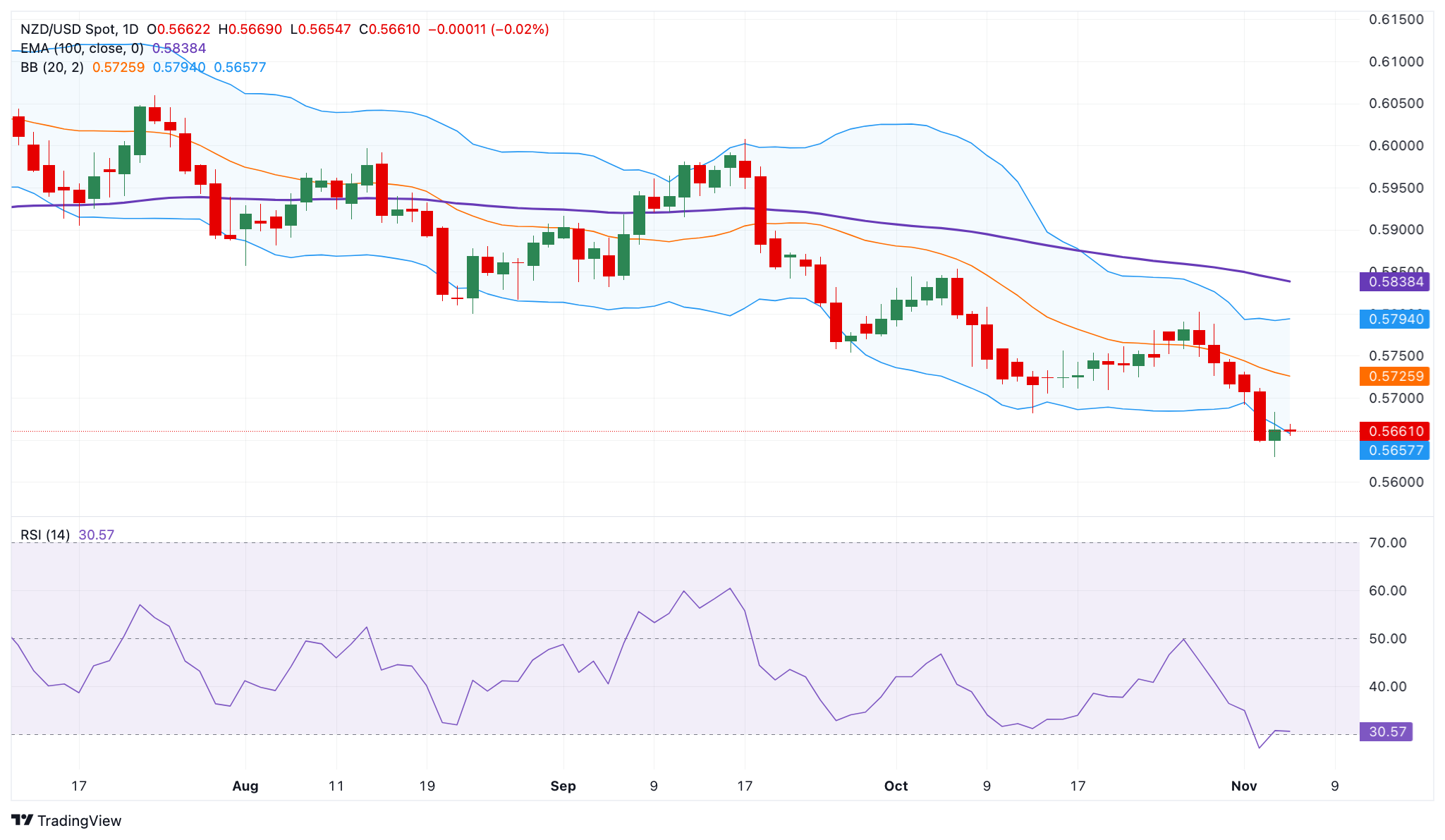NZD/USD Price Forecast: Retains bearish bias near 0.5650 below the 100-day EMA
- NZD/USD trades in negative territory around 0.5660 in Thursday’s early European session.
- The pair keeps the negative view below the 100-day EMA, with the bearish RSI indicator.
- The initial support level is located at 0.5630; the immediate resistance level is seen at 0.5754.
The NZD/USD pair posts modest losses near 0.5660 during the early European session on Thursday. The New Zealand Dollar (NZD) weakens against the US Dollar (USD) as the downbeat jobs report supported the case for a rate cut from the Reserve Bank of New Zealand (RBNZ) this month. New Zealand’s Unemployment Rate rose to 5.3% in the third quarter (Q3), the highest level since 2016. This figure followed the 5.2% recorded in Q2.
Technically, NZD/USD maintains the negative outlook on the daily chart, with the price holding below the key 100-day Exponential Moving Average (EMA). The path of least resistance is to the downside, as the 14-day Relative Strength Index (RSI) stands below the midline near 31.15. This suggests bearish momentum in the near term.
The initial support level for NZD/USD emerges at 0.5630, the low of November 5. Extended losses below the mentioned level could expose 0.5585, the low of February 28. The crucial contention level to watch is 0.5520, the low of April 8.
On the bright side, the first upside target to watch for the pair is seen at 0.5754, the low of September 26. Sustained trading above this level could see a rally to the 0.5795-0.5800 zone, representing the upper boundary of the Bollinger Band and a psychological mark. Further north, the next hurdle is located at 0.5838, the 100-day EMA.
NZD/USD Daily Chart

New Zealand Dollar FAQs
The New Zealand Dollar (NZD), also known as the Kiwi, is a well-known traded currency among investors. Its value is broadly determined by the health of the New Zealand economy and the country’s central bank policy. Still, there are some unique particularities that also can make NZD move. The performance of the Chinese economy tends to move the Kiwi because China is New Zealand’s biggest trading partner. Bad news for the Chinese economy likely means less New Zealand exports to the country, hitting the economy and thus its currency. Another factor moving NZD is dairy prices as the dairy industry is New Zealand’s main export. High dairy prices boost export income, contributing positively to the economy and thus to the NZD.
The Reserve Bank of New Zealand (RBNZ) aims to achieve and maintain an inflation rate between 1% and 3% over the medium term, with a focus to keep it near the 2% mid-point. To this end, the bank sets an appropriate level of interest rates. When inflation is too high, the RBNZ will increase interest rates to cool the economy, but the move will also make bond yields higher, increasing investors’ appeal to invest in the country and thus boosting NZD. On the contrary, lower interest rates tend to weaken NZD. The so-called rate differential, or how rates in New Zealand are or are expected to be compared to the ones set by the US Federal Reserve, can also play a key role in moving the NZD/USD pair.
Macroeconomic data releases in New Zealand are key to assess the state of the economy and can impact the New Zealand Dollar’s (NZD) valuation. A strong economy, based on high economic growth, low unemployment and high confidence is good for NZD. High economic growth attracts foreign investment and may encourage the Reserve Bank of New Zealand to increase interest rates, if this economic strength comes together with elevated inflation. Conversely, if economic data is weak, NZD is likely to depreciate.
The New Zealand Dollar (NZD) tends to strengthen during risk-on periods, or when investors perceive that broader market risks are low and are optimistic about growth. This tends to lead to a more favorable outlook for commodities and so-called ‘commodity currencies’ such as the Kiwi. Conversely, NZD tends to weaken at times of market turbulence or economic uncertainty as investors tend to sell higher-risk assets and flee to the more-stable safe havens.

